Entry Database : PDB / ID : 6j00Title The RNA-dependent RNA polymerase domain of dengue 3 NS5 Genome polyprotein Keywords / / / Function / homology Function Domain/homology Component
/ / / / / / / / / / / / / / / / / / / / / / / / / / / / / / / / / / / / / / / / / / / / / / / / / / / / / / / / / / / / / / / / / / / / / / / / / / / / / / / / / / / / / / / / / / / / / / / / / / / / / / / / / / / / / / / / / / / Biological species Method / / / Resolution : 2.14 Å Authors Shimizu, H. / Sekine, S. Funding support Organization Grant number Country Japan Agency for Medical Research and Development (AMED) Japan Society for the Promotion of Science 17K07322
Journal : Plos Negl Trop Dis / Year : 2019Title : Discovery of a small molecule inhibitor targeting dengue virus NS5 RNA-dependent RNA polymerase.Authors : Shimizu, H. / Saito, A. / Mikuni, J. / Nakayama, E.E. / Koyama, H. / Honma, T. / Shirouzu, M. / Sekine, S.I. / Shioda, T. History Deposition Dec 20, 2018 Deposition site / Processing site Revision 1.0 Dec 25, 2019 Provider / Type Revision 1.1 Jan 13, 2021 Group / Category / citation_authorItem _citation.country / _citation.journal_abbrev ... _citation.country / _citation.journal_abbrev / _citation.journal_id_CSD / _citation.journal_id_ISSN / _citation.journal_volume / _citation.page_first / _citation.page_last / _citation.pdbx_database_id_DOI / _citation.pdbx_database_id_PubMed / _citation.title / _citation.year Revision 1.2 Nov 22, 2023 Group / Database references / Refinement descriptionCategory chem_comp_atom / chem_comp_bond ... chem_comp_atom / chem_comp_bond / database_2 / pdbx_initial_refinement_model Item / _database_2.pdbx_database_accession
Show all Show less
 Open data
Open data Basic information
Basic information Components
Components Keywords
Keywords VIRAL PROTEIN /
VIRAL PROTEIN /  Dengue / NS5 /
Dengue / NS5 /  RNA-dependent RNA polymerase
RNA-dependent RNA polymerase Function and homology information
Function and homology information viral capsid /
viral capsid /  double-stranded RNA binding / protein complex oligomerization / monoatomic ion channel activity ...symbiont-mediated suppression of host JAK-STAT cascade via inhibition of host TYK2 activity / host cell mitochondrion / symbiont-mediated suppression of host JAK-STAT cascade via inhibition of STAT2 activity / symbiont-mediated suppression of host cytoplasmic pattern recognition receptor signaling pathway via inhibition of MAVS activity / ribonucleoside triphosphate phosphatase activity / : /
double-stranded RNA binding / protein complex oligomerization / monoatomic ion channel activity ...symbiont-mediated suppression of host JAK-STAT cascade via inhibition of host TYK2 activity / host cell mitochondrion / symbiont-mediated suppression of host JAK-STAT cascade via inhibition of STAT2 activity / symbiont-mediated suppression of host cytoplasmic pattern recognition receptor signaling pathway via inhibition of MAVS activity / ribonucleoside triphosphate phosphatase activity / : /  viral capsid /
viral capsid /  double-stranded RNA binding / protein complex oligomerization / monoatomic ion channel activity / clathrin-dependent endocytosis of virus by host cell /
double-stranded RNA binding / protein complex oligomerization / monoatomic ion channel activity / clathrin-dependent endocytosis of virus by host cell /  mRNA (nucleoside-2'-O-)-methyltransferase activity / mRNA 5'-cap (guanine-N7-)-methyltransferase activity /
mRNA (nucleoside-2'-O-)-methyltransferase activity / mRNA 5'-cap (guanine-N7-)-methyltransferase activity /  RNA helicase activity / host cell endoplasmic reticulum membrane /
RNA helicase activity / host cell endoplasmic reticulum membrane /  protein dimerization activity / induction by virus of host autophagy / viral RNA genome replication /
protein dimerization activity / induction by virus of host autophagy / viral RNA genome replication /  RNA-dependent RNA polymerase activity / serine-type endopeptidase activity / fusion of virus membrane with host endosome membrane /
RNA-dependent RNA polymerase activity / serine-type endopeptidase activity / fusion of virus membrane with host endosome membrane /  viral envelope / symbiont-mediated suppression of host type I interferon-mediated signaling pathway / host cell nucleus / virion attachment to host cell / virion membrane / structural molecule activity /
viral envelope / symbiont-mediated suppression of host type I interferon-mediated signaling pathway / host cell nucleus / virion attachment to host cell / virion membrane / structural molecule activity /  proteolysis / extracellular region /
proteolysis / extracellular region /  ATP binding /
ATP binding /  membrane /
membrane /  metal ion binding
metal ion binding
 Dengue virus 3
Dengue virus 3 X-RAY DIFFRACTION /
X-RAY DIFFRACTION /  SYNCHROTRON /
SYNCHROTRON /  MOLECULAR REPLACEMENT / Resolution: 2.14 Å
MOLECULAR REPLACEMENT / Resolution: 2.14 Å  Authors
Authors Japan, 2items
Japan, 2items  Citation
Citation Journal: Plos Negl Trop Dis / Year: 2019
Journal: Plos Negl Trop Dis / Year: 2019 Structure visualization
Structure visualization Molmil
Molmil Jmol/JSmol
Jmol/JSmol Downloads & links
Downloads & links Download
Download 6j00.cif.gz
6j00.cif.gz PDBx/mmCIF format
PDBx/mmCIF format pdb6j00.ent.gz
pdb6j00.ent.gz PDB format
PDB format 6j00.json.gz
6j00.json.gz PDBx/mmJSON format
PDBx/mmJSON format Other downloads
Other downloads https://data.pdbj.org/pub/pdb/validation_reports/j0/6j00
https://data.pdbj.org/pub/pdb/validation_reports/j0/6j00 ftp://data.pdbj.org/pub/pdb/validation_reports/j0/6j00
ftp://data.pdbj.org/pub/pdb/validation_reports/j0/6j00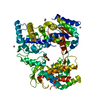


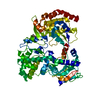
 Links
Links Assembly
Assembly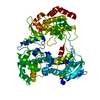
 Components
Components
 Dengue virus 3 / Production host:
Dengue virus 3 / Production host: 
 Escherichia coli KRX (bacteria) / References: UniProt: Q5I3C1
Escherichia coli KRX (bacteria) / References: UniProt: Q5I3C1 Water
Water X-RAY DIFFRACTION / Number of used crystals: 1
X-RAY DIFFRACTION / Number of used crystals: 1  Sample preparation
Sample preparation
 SYNCHROTRON / Site:
SYNCHROTRON / Site:  SPring-8
SPring-8  / Beamline: BL26B2 / Wavelength: 1 Å
/ Beamline: BL26B2 / Wavelength: 1 Å : 1 Å / Relative weight: 1
: 1 Å / Relative weight: 1  Processing
Processing :
:  MOLECULAR REPLACEMENT
MOLECULAR REPLACEMENT Movie
Movie Controller
Controller




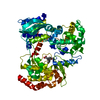

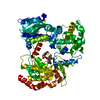

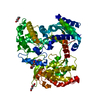




 PDBj
PDBj




